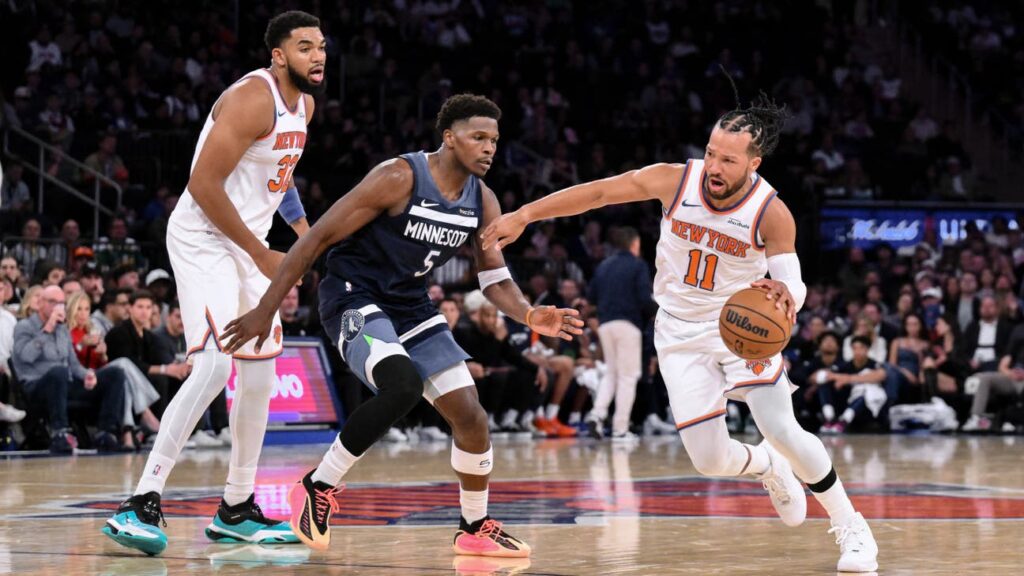We’re just three games into the preseason, but it’s been a transformative stretch for the Knicks as they build up the foundations of their restructured offense under new head coach Mike Brown.
A primary reason for hiring him was to diversify and maximize an offense that finished top five last season, but steadily declined into the playoffs and stagnated too often by admission of the players running it.
We won’t see the final results until months from now, and even early returns should be taken with a grain of salt, given the undertaking of installing a new read-and-react system in a low-stakes preseason environment. Still, we can start to spot the big differences and how that might inform what this team looks like, fully formed.
Here are three major ways this Knicks offense is different from prior iterations.
Three-point emphasis
Brown wants 40 three-pointers per game out of these Knicks, a mark well above their previous 34.1 average and one met by only four other teams during the 2024-25 season. New York is currently on pace this preseason, averaging 44 behind a revamped shot diet.
A big focus for them this training camp has been getting two feet in the paint to collapse the defense and create catch-and-shoot opportunities for shooters. The Knicks have been doing more of this thanks to increased ball and player movement, pace, and cutting down on mid-range shots.
All of their top scorers have aligned early shot diets with these principles. Out of the 32 shots Jalen Brunson has taken this preseason, only two have come from the mid-range — ditto for Karl-Anthony Towns (1 of 19), OG Anunoby (1 of 15) and even Mikal Bridges (1 for 26).
The Knicks will probably want to get a little more out of the paint and free throw line, but this is probably just a preseason thing. We’ll see how stringent these changes remain, how the personnel adjusts, and how much it boosts the offense once we’re well into the regular season.
Freelance fundamentals
One thing that looks to be consistent with last year’s approach is a reliance on freelanced offense, or trusting the talent on the court to make the right reads without relying on too many canned plays. However, where the 2025 Knicks could stagnate in their approach — often simplifying to a pet pindown or weave to get Brunson the ball in pick-and-roll or isolation — this year promises increased motion and sharing to generate looks.
Brown mentioned running no set plays in the Knicks’ most recent win, in an effort to familiarize them with the new system. Two major tenants of the approach are spacing principles and emphasis on movement.
New York is trying to be more diligent with spacing the floor by keeping players spread and in motion behind the arc, while also being smarter about how they cut into the paint. There were times last season when guys would be bunched up in the same corner, or cutting into each other on a drive. Hyperfocusing on the right positioning with no plays running should help deter those mistakes.
The other piece is increased player movement, including a ton of quick-hit dribble hand-offs, give-and-gos, and weak-side cuts and flares to keep the opportunities flowing with no set being run. There also seems to be an informal dribble or isolation limit, as the ball is moving much freer than in years past.
Quicker pace
This change has been a little tougher to gauge on the eye test and by the numbers. Partially from preseason obfuscation, partially because this might be the biggest new adjustment for New York’s top players, and partially because it’s not as simple. Increased pace means more fast breaks and quicker shots.
Some of the changes have been more subtle — like Brown preaching for guys to spread out to the corners as quick as possible semi-transition, which we’re seeing the beginnings of. But the results may not look like what some expect right away.
The Knicks won’t be turning into seven seconds or less anytime soon and probably at all, but they’re trying to get more leak-outs in transition, make space for trailers, and even get into their halfcourt stuff much quicker, which may bring the biggest impact.
A big issue with last season's offense was just taking six seconds to cross halfcourt and another eight to finally begin the action. It happened often.
Again, drawing any concrete conclusions from these early games is a fruitless exercise, but they’ve given us a real look into the core tenants Brown has been preaching for this new-look offense all training camp. It may take some time to fully realize, but we can see the building blocks starting to emerge.
Read the full article here


